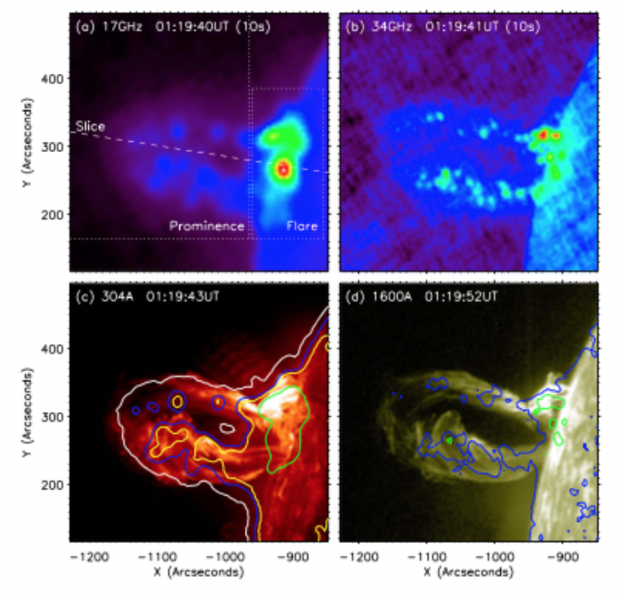We study a solar eruptive prominence with flare/coronal mass ejection (CME) event by microwave and extreme ultraviolet (EUV) observations. Its evolution can be divided into three phases: slow rise, fast expansion, and ejection. In the slow-rise phase, the prominence continuously twists for more than one hour with a patch of bright emission appearing around the top. When the north leg interacts with the local small-size loops, the fast expansion is initiated and the flare takes place there. The prominence grows rapidly, and a series of localized brightenings appear in the whole prominence structure. Then the ejection occurs, followed by a CME. This work will focus on the localized brightenings as seen in both microwave and EUV observations in the prominence body.

Figure 1 – Ten-second integrated microwave images of the prominence at 17 and 34 GHz produced by the Hanaoka code: (a)–(c) contours of Tb at 17 GHz with levels of 5000 (white), 10,000 (blue), 13,000 (yellow), and 25,000 (green) K overplotted on the 304 Å image at 01:19:43 UT; (d) contours of Tb at 34 GHz with levels of 10,000 (blue) and 25,000 (green) K overplotted on the 1600 Å image at 01:19:52 UT.
In microwave images, the brightness temperature (Tb) at 17 and 34 GHz can be divided into three components. The strongest emission with Tb at 25,000–300,000 K is related to the bright flare region near the north foot. The medium Tb (10,000–20,000 K) outlines a series of small-scale bright enhancements scattering in the prominence, which are superposed on a weak background with Tb at 5000–10,000 K (Figure 1). These localized bright structures, first appearing at the top and then scattering in the entire prominence structure, are cospatial with EUV bright threads, fibers, or spots in both high- and low-temperature passbands.
By study the evolution of two bright regions in the prominence, it is found that they display significant temporal variations on the scale of 3–5 s in the microwave observations. Thus, the plasma inside the prominence is spatially structured and changes with time in both density and temperature. Hence, the small-scale bright structure indicates an intermittent change in the plasma in the prominence. The amplitude of the enhancements could be comparable to the smooth background, so it can be a significant element for the emission of the prominence.
Conclusions
This behavior could be interpreted in the frame of the small-scale and short-term process of energy releases in the twisted magnetic structure. Particle acceleration or heating at small scale would take place in the twisted magnetic structure, which may generate a localized change in the plasma density and temperature and consequently the localized and short-period enhanced emission at both the microwave and EUV bands. The small-scale energy release can take place during the growth of the twisted magnetic structure, which may be weakened by its expansion or relaxation. Therefore, this study provides an observational proof for the small-size energy releases in the twisted magnetic structure.
Additional info
Based on the resent paper by Huang, Jing; Tan, Baolin; Masuda, Satoshi; Cheng, Xin; Bisoi, Susanta Kumar; Melnikov, Victor, Localized Microwave and EUV Bright Structures in an Eruptive Prominence, 2019, The Astrophysical Journal, 874, 176, doi: 10.3847/1538-4357/ab0e80
References
Gordovskyy, M., & Browning, P. K. 2012, SoPh, 277, 299
Karlický, M., & Kliem, B. 2010, SoPh, 266, 71
Pinto, R. F., Gordovskyy, M., Browning, P. K., & Vilmer, N. 2016, A&A, 585, A159
Zaitsev, V. V., & Stepanov, A. V. 2017, SoPh, 292, 141
*Full list of authors: Huang, Jing; Tan, Baolin; Masuda, Satoshi; Cheng, Xin; Bisoi, Susanta Kumar; Melnikov, Victor
